Rat Snakes
various
Rat snakes are constrictors from the Colubridae family of snakes.
Advertisement
Rat Snakes Scientific Classification
- Kingdom
- Animalia
- Phylum
- Chordata
- Class
- Reptilia
- Order
- Squamata
- Family
- Colubridae
- Genus
- various
- Scientific Name
- various
Read our Complete Guide to Classification of Animals.
Rat Snakes Conservation Status
Rat Snakes Facts
- Prey
- Rats, mice, birds, bird eggs, lizards
- Main Prey
- Rats and mice
- Name Of Young
- Hatchlings
- Group Behavior
- Solitary
- Fun Fact
- Rat snakes are constrictors from the Colubridae family of snakes.
- Biggest Threat
- Vehicles on roads, human encroachment
- Other Name(s)
- Corn snake, rat snake, bush snake,
- Gestation Period
- 2-3 months
- Temperament
- Generally mellow, but some species are more aggressive.
- Litter Size
- Anywhere from 3-20 eggs
- Habitat
- Dense rainforest jungles to arid deserts.
- Diet for this Fish
- Carnivore
- Lifestyle
- Diurnal
- or Nocturnal Depending on Region and Season
- Number Of Species
- 50
- Average Clutch Size
- 12
- Nesting Location
- Hollow logs, leaf litter
Rat Snakes Physical Characteristics
View all of the Rat Snakes images!
Rat snakes live in a wide range of environments.

There are roughly 50 rat snake species spread across 15 genera; they’re non-venomous and helpful garden allies. You can find them in most parts of the Northern Hemisphere, and they come in a variety of colors and patterns. They’re all oviparous and lay eggs in hollow tree stumps and quiet corners full of leaf litter; they’re also not typically aggressive.
Like the Rhinoceros snake (G. boulengeri), some sport a bright green color and a rhino-like nose; others, like the Eastern fox snake (P gloydi), are more discreet; they sport a shield pattern on their backside. These varied and adaptable snakes live in a wide range of environments.
Rat snakes are terrific climbers. Most species spend a significant amount of time in trees, on the tops of buildings, and in and around the rafters looking for their next meal. The joke about these snakes in some areas is that it’s probably a rat snake if it got into a weird place.
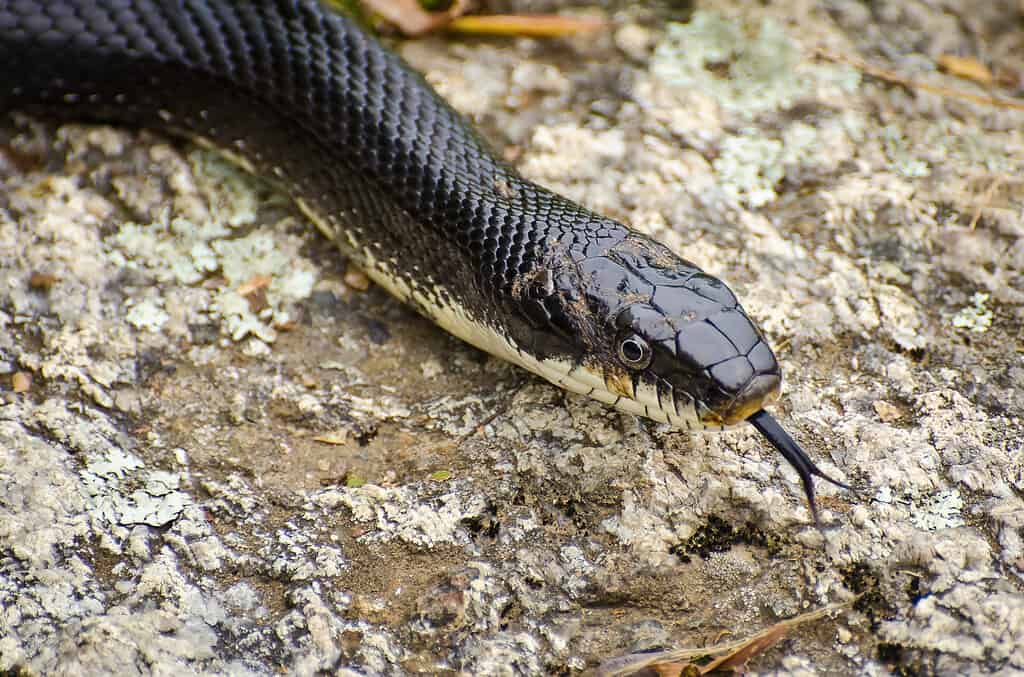
Rat snakes spend a significant amount of time in trees.
©iStock.com/RCKeller
4 Amazing Facts About Rat Snakes
- There are over 50 species, spread across most of the Northern Hemisphere.
- Some species can exceed 9 feet long.
- They get their name from their favorite prey: rats and mice.
- New World species are more closely related to king snakes than they are to the Old World rat snake species.
Habitat
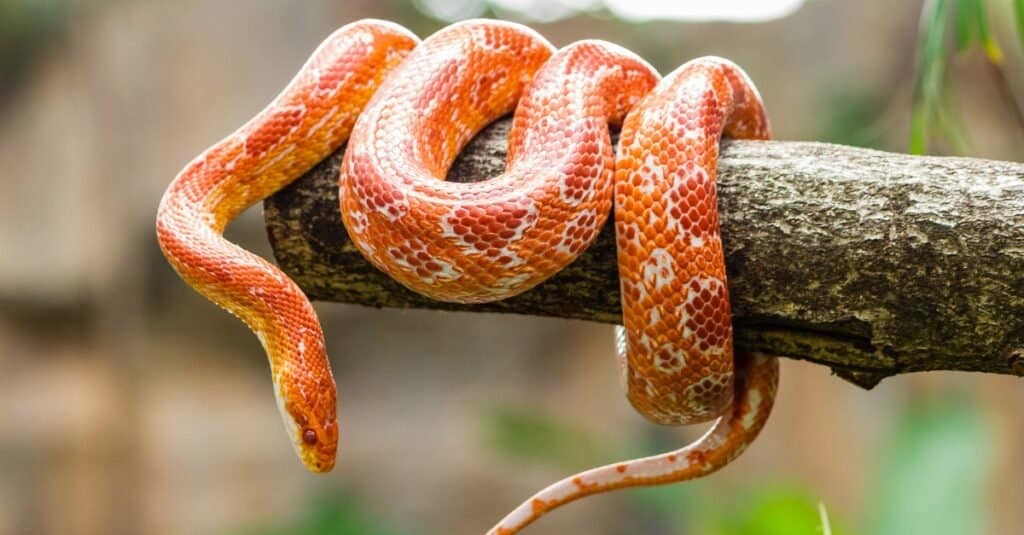
Rat snakes, like the corn snake, are active during the day and eat a variety of rodents.
©iStock.com/bugphai
These snakes are widespread; most areas of the Northern Hemisphere host at least a few of these snakes. They live in various habitats, including dense rainforests, semi-arid fields and farmland, and arid deserts. Rat snakes are regularly found in odd places, like the eaves of a roof or climbing up a brick wall. They are excellent climbers, and they often climb trees, fences, and other obstacles to get to their meals.
They’re active daytime (diurnal) hunters and eat a variety of rodents, including rats, mice, and even squirrels and chipmunks. Juveniles will sometimes eat lizards, but adults almost exclusively prefer warm-blooded prey.
Most rat snake species have adapted well to humans, and many are found on the hunt, slithering around the edges of homes and buildings.
Read here to find out about rat snakes in Florida. You can also read here to find out about three rat snakes in Georgia.
Scientific Name
Rat snakes are a large group of snakes from the suborder Colubrinae in the family Colubridae. Colubridae is the largest family of snakes; its members make up approximately 75% of all snake species. Some species were reclassified from Elaphe to other genera in recent years, including Pantherophis, Orthiophis, Zamenis, and others.
Until the early 2000s, scientists lumped most of them into the Elaphe genus because they believed they were all closely related. However, when they did DNA analysis of several Old and New World species, they discovered it was more complicated than they realized. The Old and New World species aren’t all that closely related, and in fact, the New World rat snakes are more closely related to kingsnakes than the Old World rat snakes.
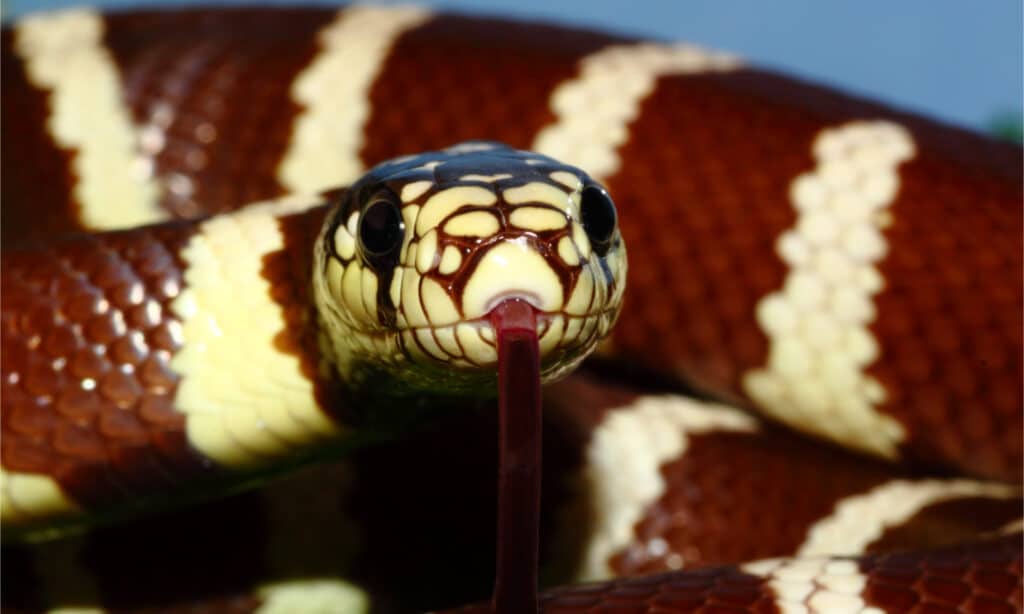
New World rat snakes are closely related to kingsnakes, such as this California Kingsnake.
©MattiaATH/Shutterstock.com
It gets better – not all the groups that research and name reptiles agree. For example, in 2002, herpetologist Urs Tiger suggested renaming most North American species Pantherophis, the Global Biodiversity Information Facility (GBIF), and the Society for the Study of Amphibians and Reptiles (SSAR) agreed; they now recognize Pantherophis. However, International Commission on Zoological Nomenclature (ICZN) and the Convention on International Trade in Endangered Species (CITES) don’t appear to, but those things can and do change.
Species
There are approximately 50 species of these harmless reptiles. The Old World species inhabit Europe & Asia, while the New World species inhabit the Americas. They’re primarily arboreal and have a wide variety of patterns – they can be blotchy or striped, or solid-colored. A few have long pointy noses, and some are multi-colored.
Old World Group
This group of rat snakes lives in most places in the Eurasian continent and into Southeast Asia.
Coelognathus
Snakes in this genus inhabit areas of Southeast Asia. It includes:
- Philippine rat snake (C. erythrurus)
- Yellow-striped snake (C. flavolineatus)
- Trinket snake (C. helena)
- Copperhead rat snake (C. radiatus)
- Indonesian rat snake (C. subradiatus)
Elaphe
This genus is widely distributed in the Northern Hemisphere:

Japanese Rat Snake is known for climbing high into trees and taking baby birds out of their nests.
©yamaoyaji/Shutterstock.com
- Twin-spotted rat snake (E. bimaculata)
- King rat snake (E. carinata)
- Japanese rat snake (E. climacophora)
- David’s rat snake (E. davidi)
- Dione rat snake (E. dione)
- Japanese four-lined rat snake (E. quadrivirgata)
- Four-lined snake (E. quatuorlineata)
- Red-backed rat snake (E. rufodorsata)
- Eastern four-lined snake (E. automates)
- Russian rat snake (E. schrenckii)
Euprepiophis
These snakes occur in Japan and China:
- Japanese forest rat snake (E. conspicillatus)
- China’s pearl-banded rat snake (E. perlacea)
Gonyosoma
These rat snakes inhabit areas of China, India, Southeast Asia, Malaysia, and Indonesia. This genus displays a wide variety of colors, and some sport a rhino-like horn on the tip of their nose.

Rhino snakes are common in Southeast Asia, and have a horn-like projection from the tip of their nose.
©Eric Isselee/Shutterstock.com
- Assam trinket snake (G. frenatum)
- Celebes black-tailed rat snake (G. jansenii)
- Red-tailed rat snake (G. oxycephalm)
- Blue-eyed bush rat snake (G. coeruleum)
- Rhinoceros snake (G. boulengeri)
- Hainan rhinoceros snake (G. hainanense
- Rainbow tree snake (G. margaritatum)
- Green trinket snake (G. prasinum)
Oreocryptophis porphyracea
This is another Southeast Asian genus with one species.
- Mountain rat snake (O. porphyracea)
Orthriophis
These snakes inhabit China and Southeast Asia.
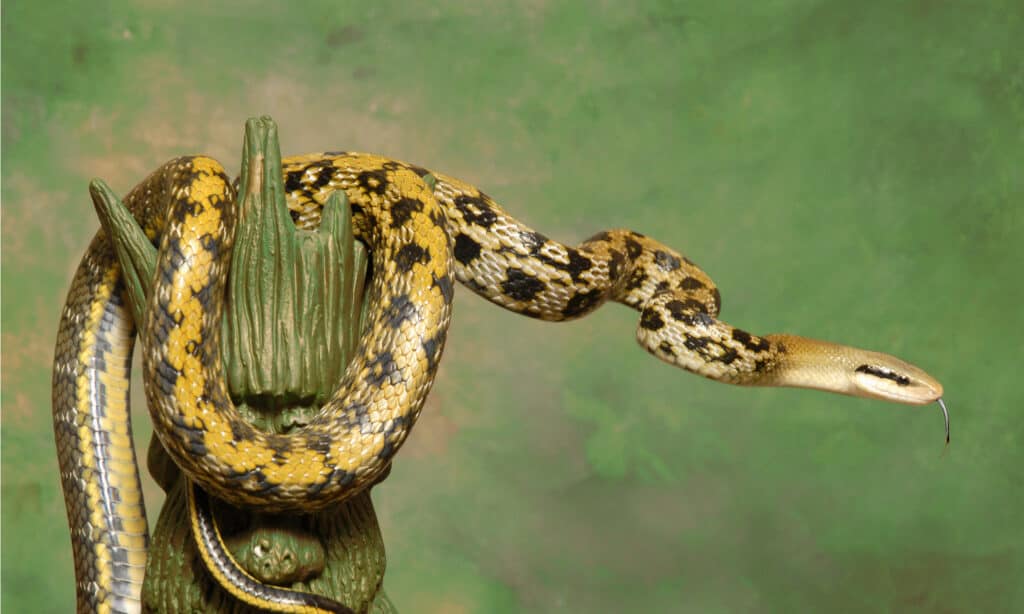
The body of the beauty rat snake ranges from yellowish-brown to an olive-green hue, though the tail is darker than the head.
©Blue Iris/Shutterstock.com
- Cantor’s rat snake (O. cantoris)
- Hodgson’s rat snake (O. hodgsoni)
- Chinese beauty snake (O. taeniurus)
- flower snake (O. moellendorffi)
Ptyas
This group is a Southeast Asian genus:
- Keeled rat snake (P. carinata)
- Sulawesi black racer (P. dipsas)
- White-bellied rat snake (P. fusca)
- Chinese rat snake (P. korros)
- Oriental rat snake (P. mucosa)
- Green rat snake (P. nigromarginata), P. dhumnades, and P. luzonensis
Rhadinophis
These snakes are bright green and range from 3 to 4 feet long. They inhabit areas of Burma, China, India, Malaysia, Thailand, and Vietnam.

Green bush snakes are smaller than other rat snakes, only 3-4 feet long.
©Sibons photography/Shutterstock.com
- Green bush snake (Rhadinophis prasinus)
Zamenis
Snakes in this genus inhabit Europe and the Middle East. Their genus name, Zamenis, comes from Greek and means angry. They tend to aggressively defend themselves, and some say they have a relatively short fuse.
- Transcaucasian rat snake (Z. hohenackeri)
- Italian Aesculapian rat snake (Z. longissimus)
- Italian Aesculapian rat snake (Z. lineatus)
- Persian rat snake (Z. persicus)
- Ladder snake (Z. scalaris)
- Leopard snake (Z. situla).
New World Group
Bogertophis
The desert rat snakes inhabit areas of the Southwest United States and northern Mexico.
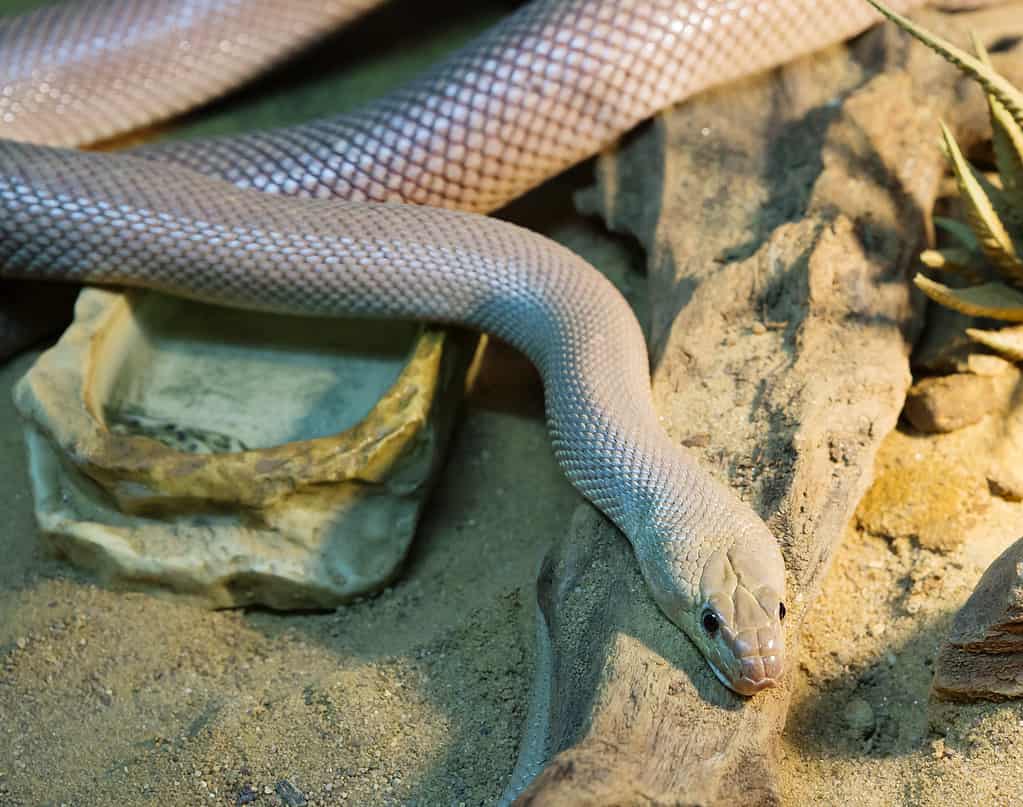
Baja California rat snake is a rare snake that inhabits the arid areas of California.
©iStock.com/User10095428_393
- Baja California rat snake (B. rosaliae)
- Trans-Pecos rat snake (B. subocularis)
Pantherophis
The majority of snakes in the New World group are Pantherophis.
Pseudelephe
There are two Mexican species, and both inhabit Yucatan, but the yellow-red rat snake also occurs in Eastern Mexico, Belize, Guatemala, Honduras, and Nicaragua.
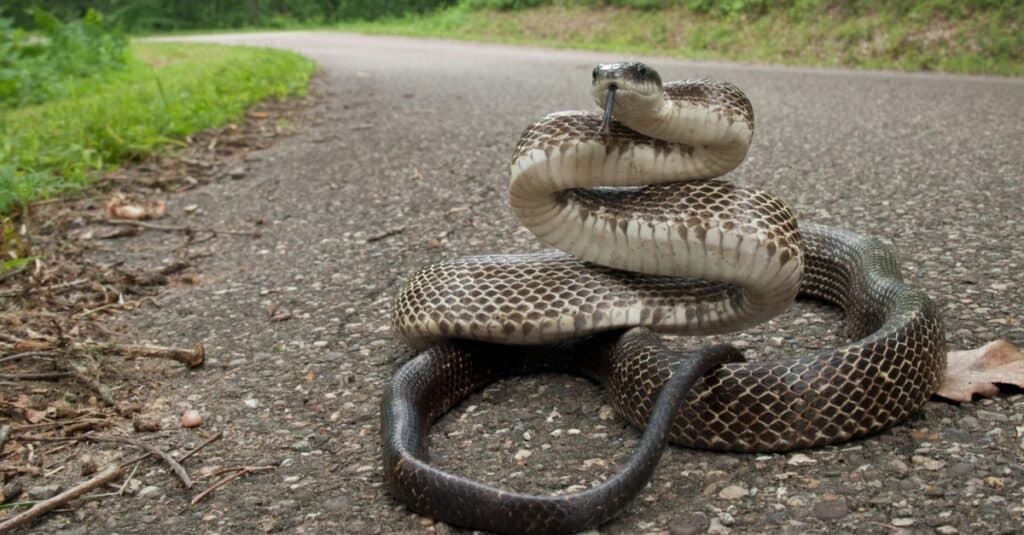
Large adult Eastern black rat snake in defensive coiled posture on a road. When threatened, rat snakes will “rattle” their tail, fooling other animals into believing they are venomous.
©Mike Wilhelm/Shutterstock.com
- Eastern rat snake (P. alleghaniensis)
- Baird’s rat snake (P. bairdi)
- Great plains rat snake (P. emoryi)
- Eastern fox snake (P. gloydi)
- Western fox snake (P. ramspotti)
- Corn snake (P. guttatus)
- Western rat snake (P. obsoletus)
- Slowinski’s corn snake (P. slowinskii)
- Gray rat snake (P. spiloides)
- Yellow-red rat snake (P. flavirufa)
- Yucatan rat snake (P. phaescens)
Senticolis
This snake inhabits many western areas of Central America.
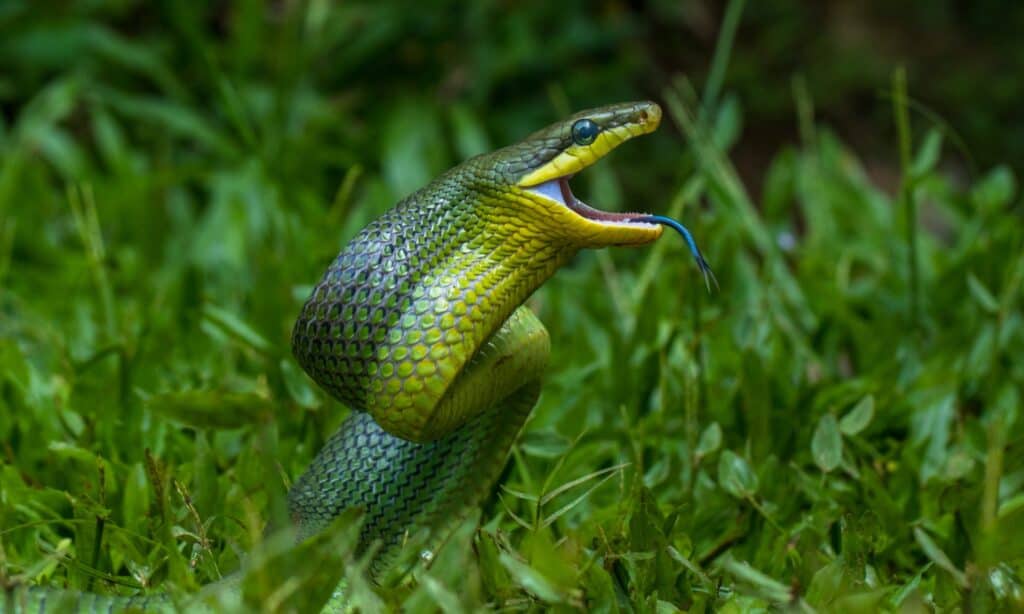
The top of the head of the Green Rat Snake may be a darker shade of green, yellow, or yellow-green.
©iStock.com/LESSY SEBASTIAN
- Green rat snake (S. triaspis)
Spilotes
Spilotes is a single-species genus, that occurs from Eastern Mexico into South America in southern Brazil, southeastern Paraguay, and northeastern Argentina.
- Chicken, or yellow rat, snake (S. pullatus)
Evolution

Fossil records show that snakes first appeared during the Cretaceous period – although they often retained their hind limbs. The earliest true snake fossils come from the marine simoliophiids, the first being Hassiophis terasanctus, dated between 112 – 94 million years ago.
Scientists believe that snakes descended from lizards. Pythons and boas, the most primitive snakes, have vestigial hind limbs and some have remnants of a pelvic girdle appearing as horny projections.
Many modern snakes originated during the Paleocene alongside the radiation of mammals that occurred after the extinction of non-avian dinosaurs. The expansion of grasslands in North America led to a major radiation of snakes. During the Miocene, the number of snake species increased with the first vipers and elapids and the diversification of Columbridae.
Population and Conservation
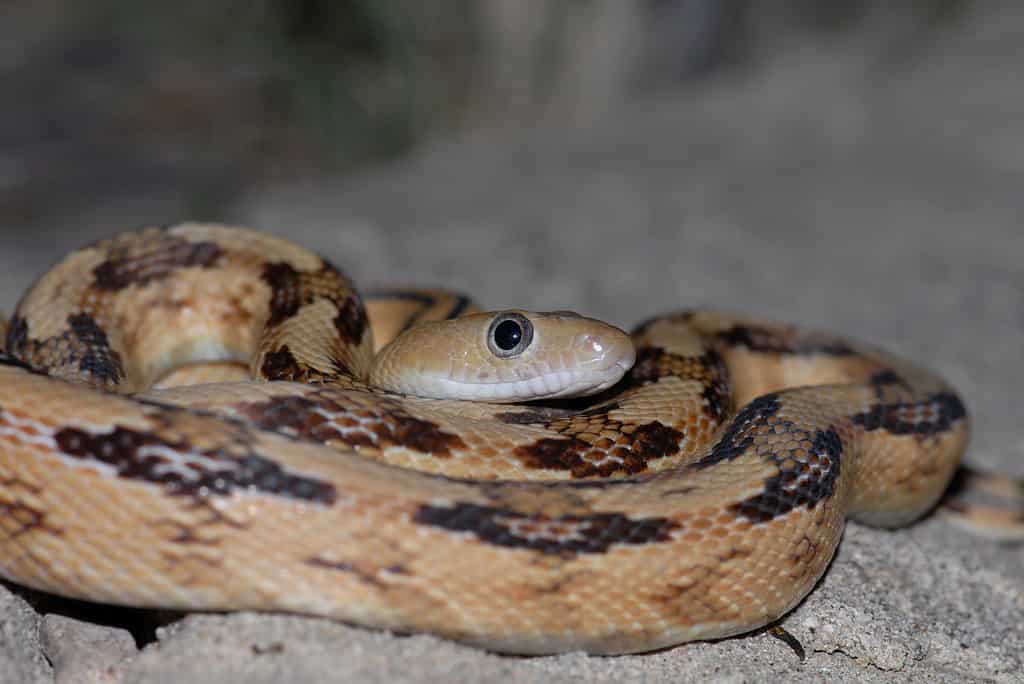
Trans-Pecos rat snakes are nocturnal snakes so are rarely seen, although when they are they are not usually aggressive.
©Rusty Dodson/Shutterstock.com
There are a few listed on IUCN Redlist as vulnerable or endangered, such as the cave racer (E. Teniura) and pearl-banded rat snake in China (E. perlacea). Still, the IUCN Redlist says that most species have stable populations. However, many aren’t on the list because there isn’t enough information.
Predators and Threats
Many animals prey on rat snakes, including weasels, badgers, birds of prey, coyotes, and other snakes. Their main threat varies depending on where they live. Human encroachment can be an issue, but more often, it’s vehicle encounters and illegal harvesting of the snakes for the pet trade. In some areas, weather such as a hurricane is a threat because of the flooding caused by the storms.
Diet
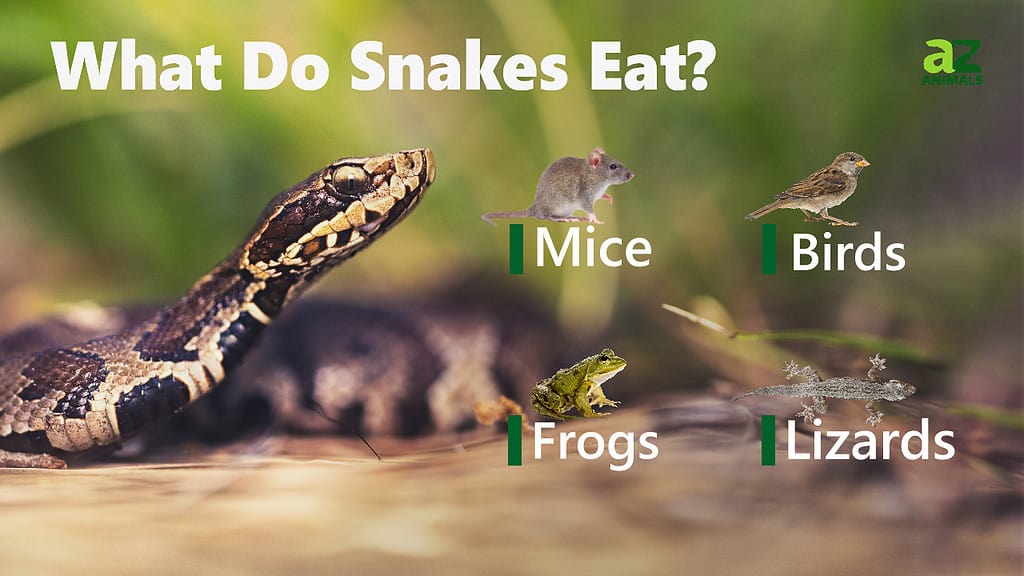
Appearance & Description
These snakes are medium to large, sometimes very long, and somewhat slender. They are constrictors from the Colubridae family and kill their prey by grabbing onto it and suffocating it. They range in length from 3 feet to over 9 feet long, and their favorite pastime seems to be getting into odd positions that defy logic. For example, people routinely find a rat snake wedged into the grout lines of bricks as it makes its way from one place to another. They can’t grab onto the bricks as a lizard can, so they wedge themselves into cracks and crevices using their belly scales as leverage for movement.
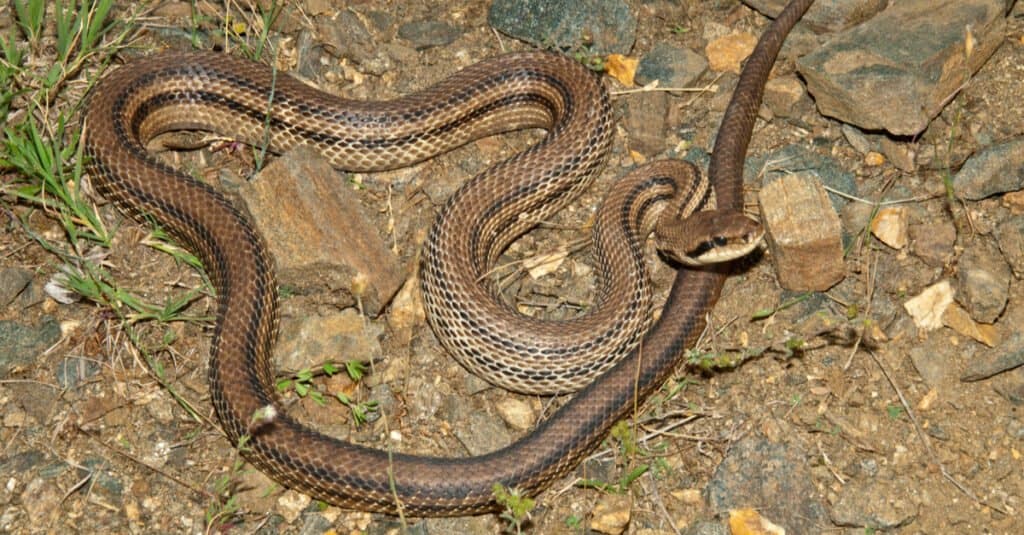
– the four-lined rat snake occurs in Macedonia and Greece.
©imageBROKER.com/Shutterstock.com
In most species, their heads are turtle-shaped, some have what looks like a ghost in the pattern on the tops of their heads, and many have a lighter background color with darker shield-shaped patterns down the length of their backs. Of course, not all have these features, but enough of them make identifying them easier.
Are they Dangerous?
These aren’t dangerous to humans. However, some snakes in the Old World group have very mild venom in their mouths that does not affect people or dogs; none of them have fangs to inject any venom. A few of the larger species can deliver a painful bite because they have strong jaws.
Sometimes rat snakes will get into chicken coops and eat the eggs and chicks, so some people aren’t excited about seeing one. They can get very long, so they sometimes look dangerous, but they’re harmless.
Behavior and Humans

Corn snakes
are one of the most popular pet snake species because they’re easy for beginners to handle.
©Blue Dog Studio/Shutterstock.com
Many species have adapted well to humans and hide out under houses, in attics, and around yards. Rat snakes are active daytime hunters. However, some are flexible, so they also hunt in the early evening and morning hours.
If you find one in your garage, there’s nothing to fear. Rat snakes are appropriately named; they eat rats and mice that cause damage. Unfortunately, they also eat chicken eggs and chicks if they can. They may also frighten you by poking their heads out from some crevice above your head.
If you startle one, it will rattle its tail against something to make some noise imitating a rattlesnake, and it may bite, but unless it’s a giant rat snake, it probably won’t hurt very much and will only need a little basic first aid.
Similar Animals
View all 114 animals that start with RRat Snakes FAQs (Frequently Asked Questions)
Are rat snakes venomous?
They’re not dangerous to humans and are non-venomous. Some Old World rat snakes have a small amount of weak venom that doesn’t affect humans or dogs, but they have no fangs and cannot inject it.
How do rat snakes hunt?
Most rat snakes are primarily arboreal and cruise through the trees hunting for their prey.
Are rat snakes aggressive?
Not generally, but some people consider Old World rat snakes more cranky than New World rat snakes.
Where do rat snakes live?
They’re pretty widespread! Rat snakes inhabit most areas in the Northern Hemisphere.
What do rat snakes eat?
They’ll eat lizards, birds, and bird eggs, but most prefer mammals like rats and mice.
What are the key differences between a rat snake and a coachwhip snake?
Coachwhip snakes and rat snakes differ in size, speed, habitat, and appearance.
Thank you for reading! Have some feedback for us? Contact the AZ Animals editorial team.
Sources
- Michigan State University | Natural Features Inventory / Accessed February 23, 2022
- Smithsonian National Zoo / Accessed February 23, 2022
- Maryland Zoo / Accessed February 23, 2022
- Reptile Database / Accessed February 23, 2022
- RepFocus.dk / Accessed February 23, 2022
- Research Gate / Published July 1, 2021 / Accessed February 23, 2022
- Thai National Parks / Accessed February 23, 2022


















